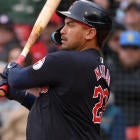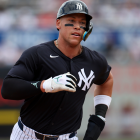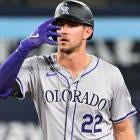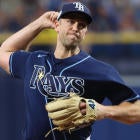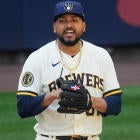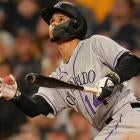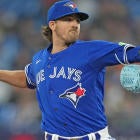Editor's Note: CBS Sports is hosting a one-day Fantasy Baseball league for opening day on FanDuel. It's $10 to enter and pays out $20,000 in cash prizes. First place wins $3,000 and four tickets to the game of their choice. You can join here.
White: Sleepers
2.0 | Breakouts
2.0 | Busts
2.0
Melchior: Sleepers
2.0 | Breakouts
2.0 | Busts
2.0
With spring training set to close next week and big drafts on the horizon, you may feel differently about some players now than you did when camps opened. But, for example, should you really be swayed by the tepid stats put up by Marcell Ozuna and Ben Revere this spring? They wouldn't be the first established players to struggle against inferior talent over the course of a couple dozen exhibition contests, and there is no reason to panic because of it. Similarly, it's not advisable to go completely gaga over Anthony DeSclafani or David Buchanan just because of good numbers put up over fewer than 20 innings.
So while it is due time to refresh my initial bust list from over a month ago, I am not making a single change to it due to spring training performances. Yes, Yan Gomes and James Shields are having very good springs, but I'm not letting them off the hook. Over the last couple of seasons, both players have shown signs in games that counted that they could struggle to live up to their draft position.
However, I have removed three players -- Brett Lawrie, Brett Gardner and Marlon Byrd -- from my initial list, because frankly, they haven't been nearly as popular in drafts as I expected they would be. Even with those subtractions, you will still get your USDA recommended daily allowance of negativity in this revised list, and I have added three players who are getting drafted earlier than they should be.
Before I start piling on, here's my annual caveat regarding how I view potential busts. These are not necessarily players I dislike or don't want to own. I just don't want to have to pay the going rate for any of them. I'd be glad to have Sonny Gray or Albert Pujols on my roster, provided they fall farther in my drafts than they have in a typical league.
Note: All batted ball distance data is courtesy of BaseballHeatMaps.com.
The Newcomers
Mark Trumbo, OF, Diamondbacks (Roto: Rd 11, H2H: Rd 13)
A stress fracture in his foot not only kept Trumbo out for close to half of the 2014 season, but it likely contributed to the extended power drought he suffered when he came off the disabled list. Trumbo did finish strong, and there is little reason to doubt a return to a 30-homer pace. There is also little reason to expect him to rise above the .230s averages and .290s on-base percentages he has posted in each of the last two seasons. That level of production could make it hard for Trumbo to crack the top 50 among outfielders, yet he is inside the top 40 in average draft position (ADP), even in Head-to-Head leagues, which is not his best format. Trumbo's best hope to justify that draft position is to cut back on strikeouts, which seeems unlikely after three straight years of K-per-at bat rates above 27 percent, or good luck on balls in play, which is never safe to assume.
Jesse Hahn, SP, Athletics (Roto: Rd. 28, H2H: Rd. 28)
On average, Hahn is being drafted in the reserve rounds of standard mixed leagues (or the equivalent thereof), so owners aren't going completely overboard to draft him. Then again, there are enough warning signs for him that he is best avoided in standard mixed leagues altogether. During his brief time in the minors, Hahn wasn't much of a bat-misser, and his control was merely average, so when the Padres promoted him from Double-A last June, he looked like a candidate to be overmatched. Instead, Hahn breezed through most of his first seven starts with a 2.21 ERA, 10.4 K/9 ratio and a 12 percent whiff rate.
After the All-Star break, Hahn reverted to being a contact pitcher, and his results reflected it (4.13 ERA, 6.3 K/9). In his pre-break starts, he did get more vertical movement on his curveball -- the pitch that was generating the bulk of his whiffs -- so maybe he can boost his K-rate. At this early stage of Hahn's career, I'm more inclined to trust his late-season peripheral stats, which are more in line with those from his minors career. He has been a consistent inducer of ground balls, but that alone doesn't make him a pitcher worthy of targeting in standard mixed leagues, even in the endgame.
Trevor Rosenthal, RP, Cardinals (Roto: Rd. 10, H2H: Rd. 6)
Rosenthal was a top 10 closer in points leagues a season ago, but it was his 45 saves that did the heavy lifting. A 1.41 WHIP sank him to 18th place among relievers in Rotisserie value, yet he currently ranks among the top 10 in both Head-to-Head and Roto ADP. In fact, he trails only Greg Holland, Craig Kimbrel and Aroldis Chapman in Head-to-Head ADP.
Rosenthal would need to improve greatly to live up to his draft position, but there is a good chance that he loses production. Perhaps he can reduce his walks, but given that a 1.20 WHIP can make a closer suspect, he will need a lot of improvement in that area. If Rosenthal isn't a substantially better closer in the early going, it's not hard to imagine Cardinals manager Mike Matheny promoting Jordan Walden from the setup role. Without a shot at 40-plus saves, it seems unlikely that Rosenthal sniffs anywhere in the vicinty of the top 10 at his position.
The Holdovers
Yan Gomes, C, Indians (Roto: Rd. 11, H2H: Rd. 14)
It wasn't until after the All-Star break in 2013 that Gomes nailed down his status as the Indians' No. 1 catcher, and it left Fantasy owners wondering what he could do with a full season of regular play. That question was apparently answered last season with a .278 batting average, 21 home runs and 74 RBI, which was good for a No. 5 ranking among catchers in Rotisserie value and a No. 7 ranking in Fantasy points. Gomes actually hit 16 points higher in '13, but the batting averages from each of the last two years could have been flukes. Last season, he didn't come close to the .297 average on grounders he posted in the first year, and he needed a 28 percent line drive rate to make up for it. Even if Gomes can somehow repeat that unusually high line drive rate, he could drop in value by losing short-distances homers, of which he had 12 last season, according to ESPN's Home Run Tracker. That's a lot of risk for a catcher that many owners could pursue as one of the top six options at the position.
Albert Pujols, 1B, Angels (Roto: Rd. 5, H2H: Rd. 4)
A mild power resurgence and improved health launched Pujols back into the top five first basemen in Fantasy value last season, as he played 159 games and slammed 28 home runs. Though his batting average rebounded from .258 to .272, Pujols can't be counted on any longer to help in that category, and he is working with a slimmer margin of error for producing power. His flyball rate fell below 30 percent last season, and the flies he did hit travelled only 274 feet on average. It's tough to be a near-elite first baseman with fewer than 30 home runs, especially if you don't hit for a high average, and unless he changes the direction of his flyball trends, Pujols may not even reach 25 homers.
Pablo Sandoval, 3B, Red Sox (Roto: Rd. 14, H2H: Rd. 13)
If Sandoval stays healthy all season, then his inclusion on this list will be a bust. There are no signs of decline in his skill indicators. In fact, I'm not sure there is a hitter with more year-to-year consistency currently in the majors. Moreover, the move from AT&T Park to Fenway Park should give him a little extra doubles power. Maybe Sandoval has bit the injury bug back, but it's hard to ignore that last season was the first time since 2010 that he played at least 145 games. Even with full-time play in 2014, he was only marginally better than low-end types like Trevor Plouffe and Aramis Ramirez, but between his heightened counting stats and last year's postseason success, he runs the risk of being highly overrated in this season's drafts.
Starlin Castro, SS, Cubs (Roto: Rd. 11, H2H: Rd. 10)
Castro appeared to be headed for stardom after his first three seasons, but things started to unravel in his fourth season when he had started to take more called strikes and miss more of the pitches he swung at. Last year was season No. 5, and though Castro's results improved, the underlying problems persisted. His whiff rate actually grew, and his strikeout per at-bat ratio remained at 19 percent, but a .273 batting average on grounders masked the lack of improvement. Castro's .292 overall batting average gave the appearance of a rebound, but there's nothing in Castro's profile (e.g., exceptional speed, opposite field hitting) that would suggest an above-average batting average on ground balls. Still in his mid-20s, Castro could conceivably bounce back, but after two seasons of mediocre contact and pitch recognition indicators, he could just as easily revert to being a borderline option.
Yoenis Cespedes, OF, Tigers (Roto: Rd. 7, H2H: Rd. 8)
Cespedes did do a better job of making contact last season, but while he raised his batting average from .240 to .260, he traded home runs for doubles. His home run-to-flyball ratio sank from 11 percent to 8 percent, and a 15 foot decrease in his average flyball distance suggests the loss of power was real. So do the 13 homers from last season (out of a total of 22) that ESPN's Hit Tracker classified as "Just Enough." Even if you trust that you will get 20-25 home runs from Cespedes, if he doesn't steal or walk much or hit above .260, he's a poor bet to repeat as a top 20 outfielder. Cespedes' 100 RBI did much to boost his value, but he probably won't hit .307 with runners in scoring position like he did last season.
James Shields, SP, Padres (Roto: Rd. 8, H2H: Rd. 6)
Because he flopped in the postseason, some owners may shy away from Shields, depressing his price, but you still may have to pay too much. Over the years, Shields has built a reputation for being a workhorse who can be among the top contributors in strikeouts, but only the former is still true. After ranking among the top six pitchers in strikeouts in 2011 and 2012, Shields fell to 16th in 2013 and 25th last season. There has been slippage in Shields' swinging strike rate over the last two seasons, and his K/9 ratio has swooned from 8.8 to 7.7 to 7.1. With batters striking out more and more, that downward trend is even more impactful. Shields relies more than ever on piling up innings for his Fantasy productivity, and if he actually gets hurt, his value will crater.
Sonny Gray, SP, Athletics (Roto: Rd. 9, H2H: Rd. 7)
A big part of The Oxymoron's appeal last season was that he kept the ball in the park, allowing only 15 home runs in 219 innings. O.co Coliseum could have helped with that, and the 10 homers he gave up in 115 home innings looks completely repeatable. As good of a ground ball pitcher as Gray is, it's hard to see how he could have allowed only five road homers in 104 innings without a lot of luck. A 7.6 percent home run-to-flyball ratio seems a little low for someone who allowed flyballs to travel 286 feet on average (or, if you prefer, three feet farther than Ricky Nolasco). Gray is only 25, so he just may sharpen up his merely decent control or rack up called strikes like a madman, as he did in his 2013 rookie season. I just wouldn't bet a pick within the first 10 rounds of a standard mixed league draft on it.
Doug Fister, SP, Nationals (Roto: Rd. 14, H2H: Rd. 11)
Last season, Fister allowed contact at the second highest rate in the majors, sandwiched between Bartolo Colon and Mark Buehrle in those rankings. Few owners are likely to rush out to draft Colon or Buehrle in standard or shallow mixed leagues this year, but the same may not be true for Fister. After all, he led the Nationals in wins (16) and starter ERA (2.41), and he was a top 40 pitcher in Fantasy value despite making only 25 starts. What separated him from uber-contact pitchers like Colon and Buehrle was a .266 BABIP and an 84 percent strand rate. He's unlikely to come close to repeating either, and his strand rate was the highest of any qualifying starter over the last four seasons by nearly two percentage points. That's a fluke for the ages, so don't be surprised if Fister falls outside the top 60 starting pitchers this season.
Matt Garza, SP, Brewers (Roto: Rd. 29, H2H: Rd. 28)
Garza has been too injury-prone and sufficiently lacking in strikeouts in recent seasons to be pursued in mixed Rotisserie leagues, but last season's 3.64 ERA and 1.18 WHIP could convince some owners to invest a late-round pick or $1 bid. That doesn't represent a big risk, but those could be spent more wisely. Garza has typically been homer-prone, and in each of the last three seasons, flyballs hit off him have travelled at least 280 feet on average. He was fortunate to have allowed only 12 home runs over 163 1/3 innings last season. Garza's days of mixed league relevance are now long behind him, and you can leave him for your NL-only leagues.
The Dropouts
Brett Lawrie, 2B/3B, Athletics (Roto: Rd. 22, H2H: Rd. 24)
If Lawrie were staying put in Toronto, I'd actually be pretty
bullish on him. In 2014, he hit flyballs at his highest rate since his
rookie season -- you know, the one where he set the sky-high power
expectations that he has yet to fulfill. However, those long drives
might not be long enough to leave O.co Coliseum, his new home park. A
line drive approach would like serve Lawrie better in Oakland, but he's
never been that type of hitter. He also popped out more frequently last
season, and given the spacious foul territory at O.co, that's a habit
Lawrie will need to break. Without the necessary adjustments, Lawrie's
first season with the A's could be an enormous disappointment to any
owner who invests in him.
Reason for removal: Technically, I could still consider Lawrie a bust, as he is being drafted ahead of several second basemen, including Jedd Gyorko, Scooter Gennett and Aaron Hill, whom I would prefer to draft. Still, Lawrie is essentially a late-rounder, so owners aren't taking much risk in taking him. If he manages to stay healthy for a full season, he can provide a reasonable return on that modest investment with rate stats that are similar to last season's.
Brett Gardner, OF, Yankees (Roto: Rd. 16, H2H: Rd. 17)
Just as Cespedes needs another big RBI year to keep up with last
season's ranking, Gardner needs to maintain his newfound power to repeat
as a top 30 outfielder. He hit 17 home runs last season after never
having hit more than eight before. While he could be a late bloomer, I'd
just as soon make someone like Marcell Ozuna
or Michael Cuddyer my No. 3 outfielder
than gamble on Gardner. It's fair to expect him to score 80-plus runs
and steal roughly 20 bases, but even so, his production could be that of
a No. 4 or 5 outfielder.
Reason for removal: I thought owners might draft Gardner based on his 2014 stats, but his ADP suggests that skepticism on the Yankees' left fielder is rampant. I had said I'd rather draft Ozuna or Michael Cuddyer than Gardner, and the average owner in our leagues agrees so far. Gardner is being drafted right where he should be.
Marlon Byrd, OF, Reds (Roto: Rd. 24, H2H: Rd. 25)
Byrd caught our attention by mashing 25 homers for the Phillies
one season after he hit 24 homers for the Mets and Pirates. His
swing-for-the-fences approach clearly has had its benefits, but it could
take a toll as well. Last season, Byrd ranked fourth among qualifying
hitters in percentage of pitches swung at outside of the strike zone and
14th from the bottom in contact rate on those pitches. That combination
is not a good look, and he was probably fortunate to have batted .264
last year. Byrd may be able to keep up his home run pace from the last
couple of seasons, but sooner or later, the lack of plate discipline is
bound to catch up with him in the form of a poor batting average.
Reason for removal: Byrd being drafted outside the top 60? I didn't see that coming. It's hard for him to bust with such a low ADP.












